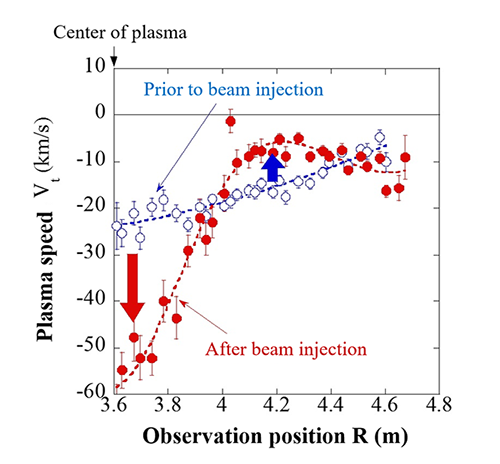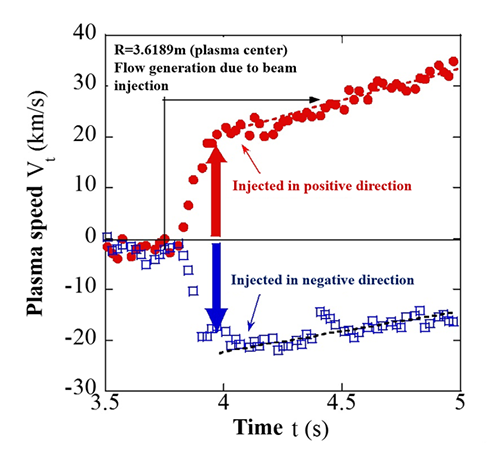HOME > Research Activities > Research Updates >
The word “flow” is commonly heard in phrases such as “flow of the river,” “air flow” (current and wind), and “the flow of people.” In plasma, too, are flows. Plasma is a gas (ionized gas) composed from particles that are electrically charged (ions and electrons), and those particles are moving about freely. It happens that those particles move as a group in certain directions. This mass movement is the plasma flow. Here, we will introduce research regarding the flow born in a plasma that is being conducted in the Large Helical Device (LHD).
In the LHD we confine high-temperature plasma in the magnetic field. That the flow that is born in the high-temperature plasma influences over plasma performance is known from research performed to date. For example, it is said that when there are slow flows and rapid flows depending upon the location plasma confinement is improved and plasma may be maintained without much difficulty at high temperatures. How is the flow in the plasma formed, and what roles does it perform? If we can clarify these issues in further detail, then we may anticipate making use of the flow in controlling plasma.
In general, in a flow there are two names for how these flows are formed. When we place a hose in a tray and pour water, we can make the water revolve. We call this type of flow an induced flow. On the other hand, when we make miso soup, many people may have seen a rising flow even when we do not mix soup in a pan. There the flow was generated as follows; the water that was heated at the bottom of the pan became lighter and rose, and was cooled on the surface and sunk to the bottom. That is, based upon the temperature differences, the flow naturally appears. We call such a flow a spontaneous flow. Even in a plasma, both a flow induced from outside and a spontaneous flow occur.
First, we focus on the spontaneous flow that occur in a plasma and we ask in what contexts does this occur. We performed experiments in the LHD. The result was that a spontaneous flow was observed when we produced a plasma with a high ion temperature. When we injected a high-energy particle beam and raised the ion temperature in the core region, the temperature difference increased between the core region and the peripheral region. The spontaneous flow based upon the temperature difference occurred. Moreover, it became clear that such a spontaneous flow was generated when we injected an electromagnetic wave into the plasma and electrons were heated.
Next, we also performed an experiment that focused upon the flow induced from outside. When we injected a high-energy particle beam into a plasma, together with the increase in the ion temperature, an induced flow occurred at the plasma core region. In the LHD, we are able to generate the induced flow under the condition where we purposely reduce the generation of the spontaneous flow by suppressing the rise of the ion temperature (reducing the plasma temperature difference) through adjusting the power of the high-energy particle beam. Using this idea, we examined in detail the induced flow by the high-energy particle beam. The injection directions of the high-energy particle beam are as follows: when a doughnut-shaped plasma is seen from above, in the clockwise direction (the positive direction) and in the counter-clockwise direction (the negative direction). When the beam in the clockwise direction and the beam in the counter-clockwise direction are each injected into a plasma, the flow is quickly induced in each direction with the approximately same magnitude of speed. Moreover, in this experiment, regardless of the injection direction, we observed some time later that the direction of the flow was gradually moving in the clockwise direction (positive direction). That is, the speed of the flow induced from outside was changing slowly. This slow-developing change is a new phenomenon that had not been anticipated. And the flow induced from outside, too, clearly was more complicated than expected. At present, the causes of these changes are thought to have been due to changes in plasma viscosity (measure of how difficult to flow: stronger the viscosity more difficult to flow).
In this way, the flow born in a plasma has come to be understood through being related through various phenomena having complicated relations such as flow induced from outside, spontaneous flow, and moreover, the changes in plasma viscosity and other issues. In the future, through more detailed investigation we will clarify how flow in a plasma is formed and what roles it fills. We are aiming to contribute to developing plasma control methods that utilize the flow.

Image 1: Spatial distribution of flow when a high ion temperature plasma is produced by injecting a high-energy particle beam in the counter-clockwise (negative direction). Compare before injecting a high-energy particle beam (blue line) and after injection (red line). In the plasma core (near the position of 3.6m) a flow (red arrow) is induced in the negative direction that is same as the injection direction. In a place distant from the core (near 4.2m), the flow direction is changing to the opposite direction (the positive direction) (blue arrow). This change is due to the spontaneous flow.

Image 2: The time change of the speed of the flow in the core area when the high-energy particle beam is injected in different directions. Due to the injection flows are quickly born in the same direction (between 3.8 seconds and four seconds) as the injection direction. However, later (after four seconds), no matter the direction of the injection, the flow moves slowly in the positive direction. This slow-moving change can be observed in the case of the flow being induced from outside.
